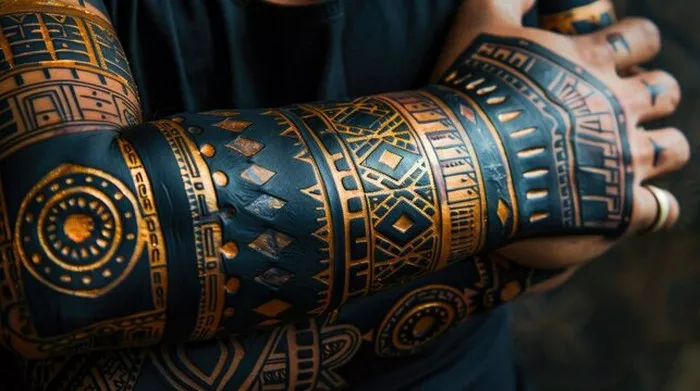Tattoos have become an integral part of personal expression, with forearm tattoos gaining popularity among men for their visibility and versatility. This article will explore various design inspirations, placement options, pain considerations, healing tips, and the symbolism behind these tattoos.
Design Inspiration
Forearm tattoos can vary greatly in style, offering something for everyone. Here are some popular styles:
1. Minimalist Tattoos:
Characterized by simple lines, shapes, and symbols, minimalist tattoos convey deep meanings without excessive detail.
Examples: Small geometric shapes, single-line drawings, or short quotes.
2. Tribal Tattoos:
Drawing inspiration from ancient cultures, tribal tattoos feature bold black lines and intricate patterns.
Examples: Polynesian or Maori designs that tell a story or represent heritage.
3. Geometric Tattoos:
Combining shapes and patterns, geometric tattoos create visually striking designs.
Examples: Mandalas, animal outlines, or abstract shapes that form a cohesive design.
4. Realistic Tattoos:
These tattoos aim to replicate lifelike images, showcasing the artist’s skill.
Examples: Portraits of loved ones, animals, or nature scenes.
Trending Designs
Current trends in forearm tattoos highlight a mix of classic and contemporary styles. Some of the most popular designs include:
Roses: Symbolizing love and beauty, rose tattoos can be depicted in various styles, from realistic to abstract.
Crosses: Representing faith and spirituality, crosses are versatile and can be combined with other elements.
Dragons: Often seen in Asian cultures, dragon tattoos symbolize strength and wisdom, making them a powerful choice.
Abstract Art: This style allows for creative freedom, resulting in unique, personalized designs that often carry personal meaning.
Symbolism and Meaning
Tattoos often carry personal significance, and understanding the symbolism behind popular designs can add depth to the artwork.
Popular Symbols
Roses: Traditionally symbolize love and beauty, but can also represent resilience and new beginnings.
Crosses: Often signify faith, spirituality, and protection.
Animals: Various animals symbolize different traits (e.g., lions for courage, owls for wisdom).
Personal Stories
Many individuals choose tattoo designs that reflect their personal journeys, beliefs, or memories. For instance:
Commemorative Tattoos: Tattoos can honor lost loved ones or significant life events, providing a permanent reminder of those experiences.
Cultural Heritage: Designs that reflect one’s cultural background can foster a sense of pride and connection to ancestry.
Milestones: Significant life achievements, such as overcoming obstacles or personal growth, can be symbolized through meaningful designs.
Placement and Size
1. Inner vs. Outer Forearm
When deciding where to place a forearm tattoo, men often choose between the inner and outer forearm. Each has its pros and cons:
Inner Forearm:
Pros: More discreet; easier to cover up for professional settings. The skin is generally softer, which may result in less pain during the tattooing process.
Cons: Can be less visible, which may not suit those looking to showcase their tattoo.
SEE ALSO: What Does a Dandelion Tattoo Mean?
Outer Forearm:
Pros: Highly visible, making it an excellent choice for showcasing artwork. Suitable for larger designs.
Cons: Higher visibility means more scrutiny; potential pain from the tattooing process, as the skin can be thinner in some areas.
2. Full Sleeve vs. Partial
Choosing between a full sleeve tattoo and partial pieces depends on personal preference and desired aesthetic.
Full Sleeve Tattoos:
Covering the entire arm from shoulder to wrist, full sleeves offer the opportunity for cohesive designs.
Pros: Allows for intricate storytelling through interconnected designs; more space for creativity.
Cons: Requires a significant time commitment and can be more expensive.
Partial Tattoos:
Smaller, individual pieces can be placed anywhere on the forearm.
Pros: Easier to manage; allows for more flexibility in design choices.
Cons: May lack the interconnected storytelling of a full sleeve.
Pain Levels
Pain is an inevitable part of the tattoo process, and understanding which areas of the forearm are more sensitive can help set expectations:
Outer Forearm: Generally, this area experiences moderate pain, as it has a fair amount of muscle and fat.
Inner Forearm: This area can be more sensitive due to thinner skin and proximity to nerves, resulting in higher pain levels.
Elbow and Wrist Areas: These joints tend to be more painful due to the thin skin and numerous nerve endings.
Aftercare Tips
Proper aftercare is essential for ensuring that a tattoo heals well and retains its beauty:
Keep It Clean: Gently wash the tattoo with mild soap and water. Pat it dry with a clean towel.
Moisturize: Apply a thin layer of fragrance-free moisturizer or specialized tattoo ointment to keep the skin hydrated.
Avoid Sun Exposure: Protect the tattoo from direct sunlight for at least a few weeks, as UV rays can fade the ink.
Do Not Scratch or Pick: Itching is common during healing; however, scratching can lead to infection or damage to the tattoo.
Stay Hydrated: Drinking plenty of water can help your skin heal faster.
Conclusion
Men’s forearm tattoos offer a unique canvas for self-expression, storytelling, and personal meaning. With a wide variety of designs, placement options, and considerations regarding pain and healing, these tattoos can be tailored to fit individual preferences and experiences. As trends continue to evolve, forearm tattoos remain a popular choice for those seeking to showcase their identity through art. Whether opting for minimalist symbols or intricate designs, each tattoo serves as a reflection of personal stories and beliefs, making them a powerful form of expression in today’s world.
Related Topics

